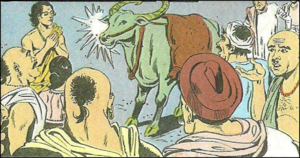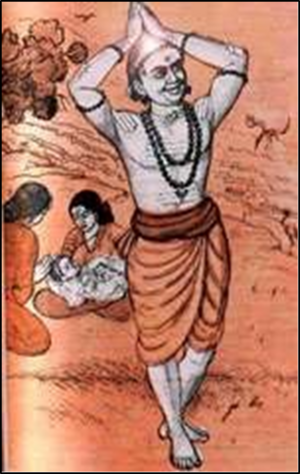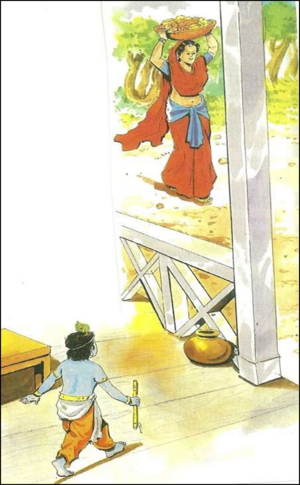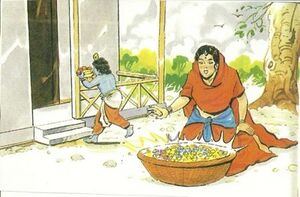Talk:Brahmadriṣhti - Sees Brahman in the entire creation, and in all creatures.
By Vishal Agarwal
In addition to treating everyone equally and with respect. The Bhakti Yogī sees Divinity within all. In the Shrimad Bhāgavata Purāṇa, Bhagavān Vishnu clearly says that his true devotees see Him in all the creatures[1]-
I abide in all beings as their innermost soul. Disregarding My Presence within them, men often make a show of worshipping Me through images. Shrīmad Bhāgavata Purāṇa 3.29.21
If one disregards Me present in all as their foundation and the Lord but ignorantly offers worship only to images, such worship is as ineffective as sacrificial offerings made in ashes. Shrīmad Bhāgavata Purāṇa 3.29. 22
A man who persecutes Me residing in others, who is proud and haughty, who looks upon God as someone different from fellow humans – such a person will never attain to peace of mind. Shrīmad Bhāgavata Purāṇa 3.29. 23
If a man disregards and persecutes fellow beings but worships Me in images with numerous rituals and rich offerings, I am not at all pleased with him for proffering such worship. Shrīmad Bhāgavata Purāṇa 3.29.24
A man should, however, worship Me in images, side by side with discharging his duties, which include the love of all beings, until he actually realizes My Presence in himself and in all beings. Shrīmad Bhāgavata Purāṇa 3.29. 25
As long as man is self-centered and makes an absolute distinction between himself and others (without recognizing the unity of all in Me, the Inner Pervader), he will be subject to the great fear of Death (including every form of deprivation of self-interest). Shrīmad Bhāgavata Purāṇa 3.29.26
So overcoming a self-centered life in which one separates himself from others, he should serve all beings with charity, honor and love, recognizing that such service is really being rendered to Me who reside in all beings as their inner-most soul. Shrīmad Bhāgavata Purāṇa 3.29. 27
The child devotee Prahlāda too taught this to his follow students-
Prahlāda said: “Behold all as your friends, because Lord Vishnu resides within everyone” Narasimha Upapurāṇa 43.15
This is not merely a theoretical principle. The lives of our Sants depict that they truly practiced perfect empathy for all creatures, and could inspire and perceive the Divine in them.
Sant Jnāneshvara Makes a Buffalo Chant the Vedas
Sant Jnaneshvara’s father had become a Sannyasi, but he returned to his wife at the command of his Guru. It was after his return to a householder’s life that Jnaneshvara and his siblings were born to the couple. In the Hindu society, once a man becomes a Sannyasi, he cannot return to the state of a householder. Therefore, the society shunned the four children and refused to accept them in their midst.
The family therefore proceeded to Paithan, a town famous for its Pandits, and the father begged them to admit the kids to their school. But the Pandits mocked, “If the child’s name is already Jnaneshvara (the Lord of Knowledge) then what is the use of his going to school?”
Suddenly, a water man was seen goading his buffalo to move forward on the road. He addressed the buffalo by its name, ‘Jnana’. The Pandits laughed and said, “Even this buffalo is called Jnana. Then is there any difference between Jnaneshvara and the buffalo?”
Jnaneshvara said, “No respected Pandits, there is really no difference. The same Atman dwells inside all of us.” Just then, the water man whipped the buffalo because the creature was removing to budge. As he hit the buffalo, the Pandits were shocked to see that the marks of the lashes started appearing on Jnaneshvara’s back instead!
Jnaneshvara said, “Indeed, no one is high or low because the same Paramatmā resides within us all.”
The Pandits would not give up. They said, “If you and the buffalo are the same, can that animal also chant the Vedas?” Jnaneshvara walked up to the buffalo and placed his hand upon its head. And to the astonishment of everyone, the buffalo started chanting the Veda Mantras!
The arrogant Pandits realized that Jnaneshvara and his siblings were saints, not ordinary children. They prostrated in front of them and sought forgiveness. They also offered to conduct the thread ceremony for the children.
However, the children decided to become ascetics, and therefore no longer needed the sacred thread. They left Paithan and became roaming ascetics. The buffalo Jnana also followed the children wherever they went till its death.
Sant Ekanāth sees Shiva in a Donkey'
Once, Sant Ekanath was travelling from Varanasi towards Rameshvaram with some water from the Ganga river. It is a Hindu tradition to offer Ganga water to the Shiva-linga at Rameshvaram. On their way, he and his disciples were travelling through an extremely hot and dry part of India. Everyone wanted to quench their thirst but the only water was the Ganga water they were carrying. No one wanted to drink it himself because it was meant for Rameshvaram. worship at Suddenly,Ekanath saw a donkey lying on the ground, dying of thirst. Ekanath was filled with compassion. He immediately took his pitcher of the Ganga water, and poured it into the mouth of the dying donkey. With its thirst quenched, the donkey revived. Shocked at this act, a disciple asked Ekanath, “Guru-ji, where will we get the water of Ganga for our worship of Rameshvara Shiva now?” Ekanath replied, “This is my Rameshvara.[2]”
Seeing the Devi in Everyone: Sant Thiruvayumanavar (1706 – 1744 CE)
Once, the Raja of Vijayanagar was returning after worshipping Ganesha and Devi in the hill-top temple in the town of Tiruchi, when he saw Thayumanavar on the roadside lost in meditation. The Raja waited for the saint to come out of his meditation, and thereafter, sought his blessings. Then, calling his attendant, the Raja said, “It is very cold today. I want you to bring the most expensive Kashmiri shawl that
we have, and give it as an offering to the saint.” The attendant brought the shawl and the Raja reverentially wrapped it around the body of the saint, and then left for his palace.
The next day, as the saint was walking by the market place, he saw an untouchable poor girl trembling with cold. The saint immediately took off his shawl, and wrapped it around the girl saying, “Mother, you need it more than I do.” When the word of this incident reached the Raja, he became very angry and said, “I had given a very precious shawl to the saint with a lot of respect. How dare he re-gift it to someone, and that too, to a miserly poor girl? I want the saint to be produced in front of me in my court so that he can explain his insulting behavior.”
When the saint came to the court and was asked to explain his behavior, he said, “King, you gave the shawl to me because you had thought of me as superior to you. Likewise, I gave the shawl to that girl because she is superior to me.” The Raja was perplexed. “How can that wretched girl be superior to you” he asked. The saint replied, “Devi Ma resides in everyone’s heart. To me, that girl was none other than the Devi. And therefore, I gave the shawl to her. You should actually feel blessed that you gift has reached none other than the Devi.” When the Raja heard this explanation, he greatly repented and fell at the feet of the saint, asking for forgiveness. He realized that Bhagavān resides in the heart of every human being, and therefore we should serve and respect every person as if he were a reflection of Bhagavān.
Bhagavan can visit in any Form
One day, Krishna was playing in his village. He saw a fruitseller lady walk by. She was selling delicious fruit. Krishna loved to eat fruit. His mother was not at home. Therefore, Krishna did not have any money to buy fruit.
He found a few grains of wheat on the floor. He picked them in his tiny palms and rushed to the fruit-seller. He said to her, “I love to eat fruit but I do not have money to pay you. I brought these grains instead of money. Can you take these grains and give me fruit to eat?”
The fruit-seller looked and Krishna and smiled. She did not know that the little kid was Bhagavān. She thought that he was just any other kid. But she said, “Do not worry little boy. You do not have to pay me. You are very truthful and honest. Therefore, you can take as many fruit from my basket as your little hands can hold.” Krishna was really happy to hear this. The fruit seller bent down and kept the basket on the ground. Then, Krishna picked several fruit and went back into His home happily.
When the fruit seller started picking up her basket, she felt that it was shining a lot. She looked into the basket and was surprised to see that all the fruit had become big diamonds and other gems! She now knew that Krishna was Bhagavān who had come in disguise. She had been kind to Him, thinking that He was just a little kid. But Bhagavān gave her a lot of riches because she was kind and loving to Him.
We Hindus believe that Bhagavān can come to visit us in many different disguises. He can come as a poor man, or a dog, or a bird. We should be kind to everyone, and should share our things with them and speak to them lovingly. You never know that your guest is actually Bhagavān Himself!






